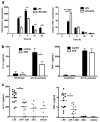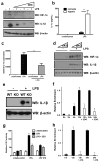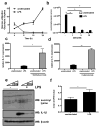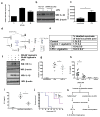Succinate is an inflammatory signal that induces IL-1β through HIF-1α
- PMID: 23535595
- PMCID: PMC4031686
- DOI: 10.1038/nature11986
Succinate is an inflammatory signal that induces IL-1β through HIF-1α
Abstract
Macrophages activated by the Gram-negative bacterial product lipopolysaccharide switch their core metabolism from oxidative phosphorylation to glycolysis. Here we show that inhibition of glycolysis with 2-deoxyglucose suppresses lipopolysaccharide-induced interleukin-1β but not tumour-necrosis factor-α in mouse macrophages. A comprehensive metabolic map of lipopolysaccharide-activated macrophages shows upregulation of glycolytic and downregulation of mitochondrial genes, which correlates directly with the expression profiles of altered metabolites. Lipopolysaccharide strongly increases the levels of the tricarboxylic-acid cycle intermediate succinate. Glutamine-dependent anerplerosis is the principal source of succinate, although the 'GABA (γ-aminobutyric acid) shunt' pathway also has a role. Lipopolysaccharide-induced succinate stabilizes hypoxia-inducible factor-1α, an effect that is inhibited by 2-deoxyglucose, with interleukin-1β as an important target. Lipopolysaccharide also increases succinylation of several proteins. We therefore identify succinate as a metabolite in innate immune signalling, which enhances interleukin-1β production during inflammation.
Figures




Comment in
-
Agitation by suffocation: how hypoxia activates innate immunity via the Warburg effect.Cell Metab. 2013 Jun 4;17(6):814-815. doi: 10.1016/j.cmet.2013.05.016. Cell Metab. 2013. PMID: 23747241
-
mSphere of Influence: Host Metabolism Is an Integral Part of the Immune Response to Infectious Diseases.mSphere. 2021 Aug 25;6(4):e0024721. doi: 10.1128/mSphere.00247-21. Epub 2021 Jul 7. mSphere. 2021. PMID: 34232079 Free PMC article.

